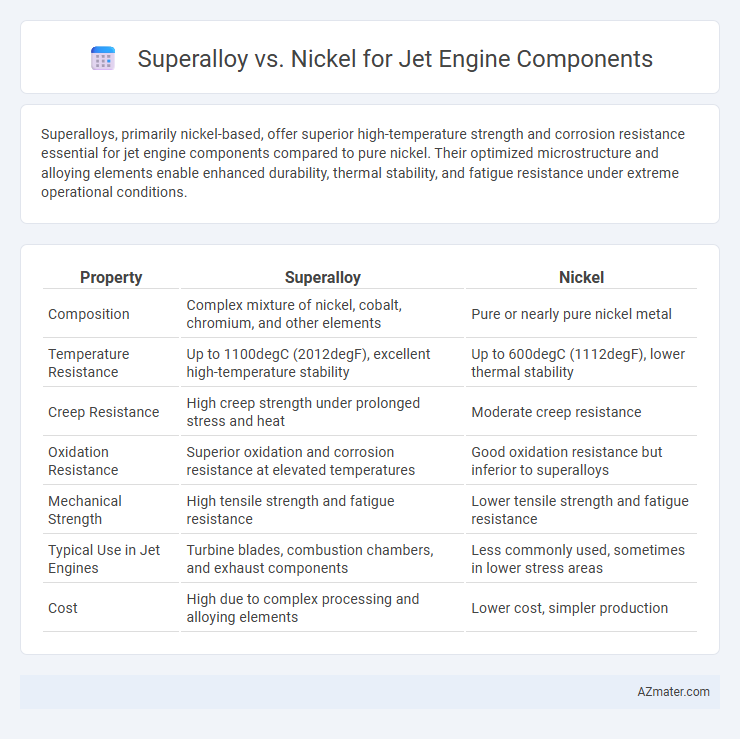Superalloys, primarily nickel-based, offer superior high-temperature strength and corrosion resistance essential for jet engine components compared to pure nickel. Their optimized microstructure and alloying elements enable enhanced durability, thermal stability, and fatigue resistance under extreme operational conditions.
Table of Comparison
| Property | Superalloy | Nickel |
|---|---|---|
| Composition | Complex mixture of nickel, cobalt, chromium, and other elements | Pure or nearly pure nickel metal |
| Temperature Resistance | Up to 1100degC (2012degF), excellent high-temperature stability | Up to 600degC (1112degF), lower thermal stability |
| Creep Resistance | High creep strength under prolonged stress and heat | Moderate creep resistance |
| Oxidation Resistance | Superior oxidation and corrosion resistance at elevated temperatures | Good oxidation resistance but inferior to superalloys |
| Mechanical Strength | High tensile strength and fatigue resistance | Lower tensile strength and fatigue resistance |
| Typical Use in Jet Engines | Turbine blades, combustion chambers, and exhaust components | Less commonly used, sometimes in lower stress areas |
| Cost | High due to complex processing and alloying elements | Lower cost, simpler production |
Introduction to Jet Engine Materials
Jet engine components demand materials with exceptional high-temperature strength, corrosion resistance, and fatigue durability, where superalloys, particularly nickel-based, dominate due to their superior performance. Nickel superalloys retain mechanical properties at extreme temperatures exceeding 1,000degC, making them ideal for turbine blades and combustion chambers. Innovations in alloy composition and microstructure engineering continuously enhance jet engine efficiency and longevity by optimizing material stability under thermomechanical stress.
Understanding Superalloys
Superalloys, primarily based on nickel, cobalt, or iron, are engineered for extreme temperature and stress conditions in jet engine components, offering superior mechanical strength and corrosion resistance compared to pure nickel. Their complex microstructure, often containing elements like chromium, aluminum, and titanium, enhances oxidation resistance and maintains stability at high thermal loads. Understanding superalloys involves recognizing their tailored compositions and heat treatments that optimize performance, crucial for turbine blades and other critical engine parts.
Overview of Nickel as a Material
Nickel serves as a critical base metal in jet engine components due to its exceptional corrosion resistance, high melting point of 1455degC, and excellent mechanical strength at elevated temperatures. Its ability to form stable oxide layers protects against harsh combustion environments, while its inherent toughness supports structural integrity under cyclic thermal and mechanical stresses. Nickel-based superalloys, which incorporate elements like chromium, cobalt, and aluminum, enhance these properties further, making pure nickel less common but foundational in advanced aerospace metallurgy.
Key Properties of Superalloys
Superalloys, primarily composed of nickel, cobalt, or iron, exhibit exceptional high-temperature strength, corrosion resistance, and thermal stability essential for jet engine components. Their ability to maintain mechanical integrity at temperatures exceeding 1000degC outperforms pure nickel, which lacks the complex alloying additions critical for creep resistance and fatigue life. Key properties such as enhanced oxidation resistance, phase stability, and microstructural control make superalloys indispensable for turbine blades, combustors, and other critical jet engine parts.
Key Properties of Nickel
Nickel's exceptional corrosion resistance and high-temperature strength make it a critical element in jet engine components, outperforming many traditional superalloys. Its ability to maintain structural integrity under extreme thermal and mechanical stresses ensures durability and efficiency in the harsh operating environment of jet engines. Nickel-based superalloys leverage these key properties, combining nickel's innate resilience with advanced alloying techniques to optimize performance for turbine blades and combustion chambers.
Performance Comparison: Superalloy vs Nickel
Superalloys, primarily nickel-based, exhibit superior high-temperature strength, oxidation resistance, and creep resistance compared to pure nickel, making them indispensable for jet engine components exposed to extreme conditions. Their advanced microstructure, reinforced with elements like chromium, cobalt, and aluminum, enhances performance longevity and thermal stability beyond what pure nickel can achieve. As a result, superalloys enable higher operating temperatures and improved fuel efficiency, significantly outperforming standard nickel in jet engine applications.
Temperature Resistance in Jet Engine Applications
Superalloys, predominantly based on nickel, exhibit superior temperature resistance in jet engine components, maintaining mechanical strength and oxidation resistance above 1000degC, essential for high-pressure turbine blades. Nickel alone offers excellent corrosion resistance but lacks the comprehensive alloying elements like cobalt, chromium, and aluminum found in superalloys that enhance creep resistance and thermal stability at extreme temperatures. The tailored microstructure and phase stability of nickel-based superalloys ensure extended component life and efficiency in the harsh thermal environments of jet engines.
Durability and Lifespan Considerations
Superalloys, primarily nickel-based, offer exceptional durability and lifespan in jet engine components due to their ability to maintain strength and resist oxidation at high temperatures exceeding 1000degC. Compared to pure nickel, advanced superalloys incorporate elements like chromium, cobalt, and aluminum to enhance creep resistance and fatigue life under extreme thermal and mechanical stresses. This superior performance ensures prolonged service intervals and reliability in critical engine parts such as turbine blades and discs.
Cost and Manufacturing Challenges
Superalloys, primarily nickel-based, exhibit exceptional high-temperature strength and corrosion resistance essential for jet engine components but come with higher raw material and processing costs compared to pure nickel. Manufacturing challenges include complex casting and machining processes required to maintain microstructural integrity under extreme conditions, leading to increased production time and expense. While nickel metal is less costly and easier to process, it lacks the performance needed for critical engine parts, making superalloys the preferred but more expensive choice for aerospace applications.
Future Trends in Jet Engine Material Selection
Superalloys, particularly nickel-based ones, remain the cornerstone in jet engine components due to their exceptional high-temperature strength, corrosion resistance, and creep resistance. Future trends in jet engine material selection emphasize the development of advanced single-crystal nickel superalloys and ceramic matrix composites to achieve higher thermal efficiency and lighter engine weight. Innovations also focus on incorporating additive manufacturing techniques to optimize material microstructure and reduce production costs while enhancing performance under extreme operating conditions.

Infographic: Superalloy vs Nickel for Jet Engine Component
 azmater.com
azmater.com